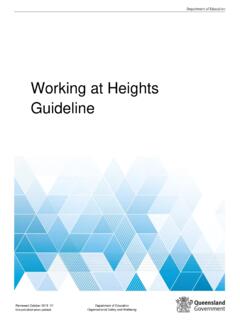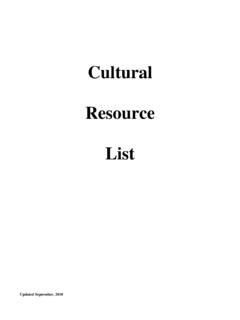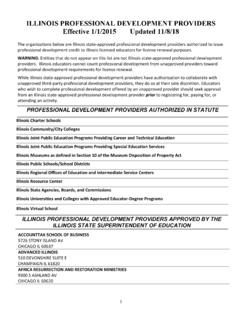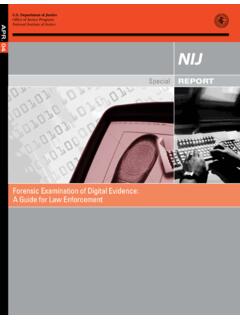Transcription of Job Safety Analysis (JSA) Guideline - .NET Framework
1 Job Safety Analysis - Guideline Version Job Safety Analysis (JSA) Guideline A job Safety Analysis (JSA) is a procedure which helps integrate accepted Safety and health principles and practices into a particular task or job operation. In a JSA, potential hazards are identified for each step of the task and controls recommended for the safest way to do the job. A JSA risk assessment must be developed when: the work activity involves a number of different tasks and hazards for which risk controls need to be planned, communicated and implemented changes at the workplace occur that may impact on the effectiveness of control measures a Permit to Work is required developing SOPs A Take 5 risk assessment can be used instead of a JSA when the work activity involves a simple task with a limited number of low risk hazards and there is good understanding about how the hazards should be controlled to ensure the task is completed safely.
2 For example doing a visual inspection of a worksite, or closing off a valve, or investigating a tripped switch. Developing a JSA The person leading the work is responsible for developing the JSA. This is typically the: Person doing the work for single person tasks Person supervising the work for team tasks Person in charge of designing new work or equipment. One method of doing a JSA is to have a group of experienced workers complete the Analysis through discussion. An advantage of this method is that more people are involved in a wider base of experience and promoting a more ready acceptance of the resulting work procedure.
3 This method is most suitable for infrequently performed or new jobs; or situations where observation may not be practical. When leading JSA discussions ask: 1. What are we doing? 2. What could go wrong? 3. What do we need to do to make it safe? These three prompt questions will provide you with the basic information needed to build your JSA. Once you have your JSA Framework built, use available guidance to ensure the risk control measured selected are sufficient to reduce the risk so far as reasonably practicable standards, best practice guidelines, WSL Key Requirements and risks assessments. Include diagrams and photos where needed.
4 Benefits of doing a JSA The JSA process helps identify hazards and increase the job knowledge of those participating. Safety and health awareness is raised, communication between workers and supervisors is improved, and acceptance of safe work procedures is promoted. Job Safety Analysis - Guideline Version Instructions JSA Process There are seven basic steps to follow: Step 1: Select job to be analysed. When writing the description of the works, clearly define the activities for which the JSA applies. Complex jobs, or jobs that last several weeks, it s often more effective to break the job Analysis into specific work packs each with an individual JSA.
5 When selecting a job to be analysed, consider the following: The scope of the work. When and where is the job performed? Who has to do it and how often? The activities involved and how are they done? What equipment or procedures are needed to perform the job safely? Step 2: Record the steps in the task. Examine a specific job by breaking it down into a series of steps or tasks. This will enable you to discover potential hazards you and the Work Team may encounter. Each job or operation will consist of a set of steps or tasks. Be sure to list all the steps needed to perform the job. Some steps may not be performed each time, setting up the work area, however, if that step is generally part of the job, it should be listed.
6 Example: Step 3: Identify the hazards and assess the risks. A hazard is a potential danger. The purpose of the Job Safety Analysis is to identify ALL hazards, both those produced by the environment or conditions and those connected with the work activities. Compiling an accurate and complete list of potential hazards will allow you to develop the recommended controls to ensure that work proceeds safely. Select job to be analysedRecord the steps in the taskIdentify the hazards and assess the control measures Follow Control of Work Proceedure to obtain authorisation to proceed with workCommunicate and implement the JSAM onitor the work and maintain controls Job Safety Analysis - Guideline Version Example: Tip: Insert a new row for each hazard identified.
7 How to Asse ss the Ri s k When we refer to risk in relation to occupational Safety and health the most commonly used definition is 'risk is the likelihood that a person may be harmed or suffers adverse health effects if exposed to a hazard.' Once you have identified the hazards involved in the task, estimate what realistic severity of harm that may occur, and the likelihood of that occurring. A risk matrix tool provides a numerical score for the risk assessment. Firstly assess the Existing Risk by: 1. Identifying the hazard; take into consideration who may be harmed and how that harm may occur 2. Identifying existing controls that will remain active during the work 3.
8 Using the risk matrix determine the LIKELIHOOD and SEVERITY of harm Job Safety Analysis - Guideline Version Example: Step 4: Develop control measures. Hierarchy of Control Reduce the LIKELIHOOD of harm occurring by adding Prevention Controls. These are controls which are designed to prevent an event occurring (the point where control is lost). For example: a guard isolates moving machinery from body parts, isolations prevent energy from harming humans, training enables workers to work safely, and signage informs others. All of these are Prevention Controls.
9 Reduce the SEVERITY of potential harm by adding Mitigation Controls. These controls acknowledge that sometimes prevention controls fail and when this happens, mitigation controls can reduce the severity of the harm. For example; seat belts and airbags in vehicles minimise the severity of harm in a crash, a harness will catch you if you fall and a rescue plan will enable the team to get you down safely. When a hazard comes into direct contact with a human, PPE can minimise the harm it causes and decontamination, evacuation and emergency plans all work to mitigate the severity of harm. Job Safety Analysis - Guideline Version Once you have planned your risk controls and added them to the JSA, assess the Residual Risk by taking into account the extra prevention and mitigation controls to work out the Residual Risk score.
10 Example: IF THE RISK RATING IS IN THE RED (4 or 5) AFTER YOUR PLANNED CONTROLS, WORK CANNOT PROCEED. The JSA needs to be reviewed by subject matter expert(s). Permit to Work Once you have completed the task Analysis section you may need to apply for a Permit to Work. 1. Use the Permit to Work Decision trees (appendix A) to work out whether a permit is required. 2. A Permit to Work is mandatory where a Y has been listed in the PTW required column. 3. Where a Y/N is indicated the = Permit Receiver and Permit Issuer must discuss planned controls to determine if a permit is required. 4. The Permit Receiver must fill in the permit certificates obtain PTW forms from your Watercare Representative 5.







